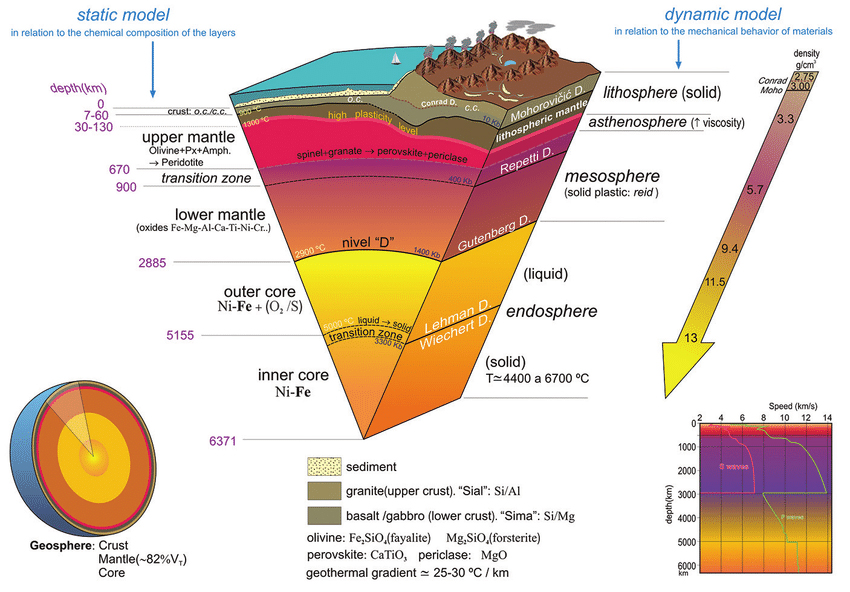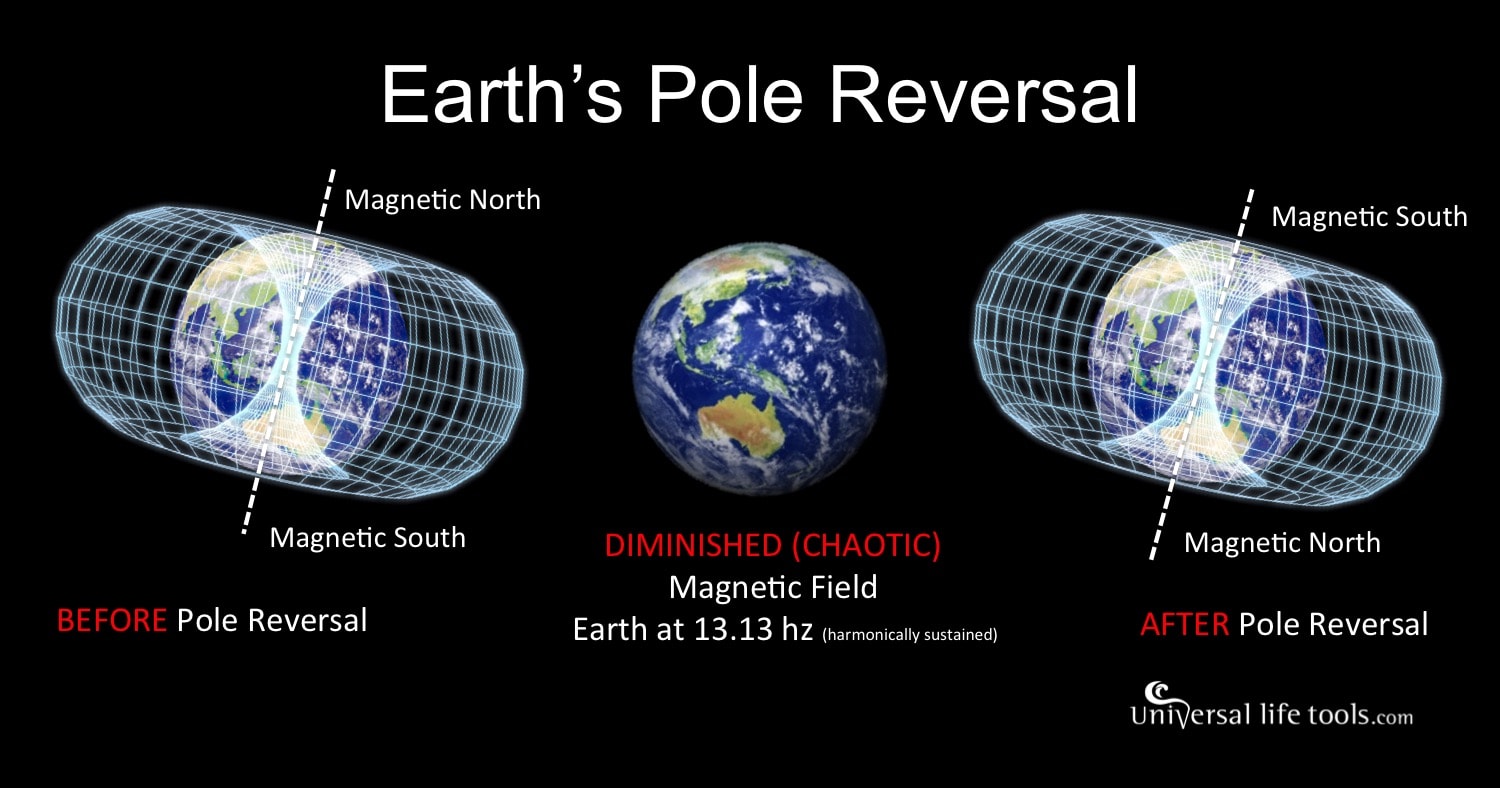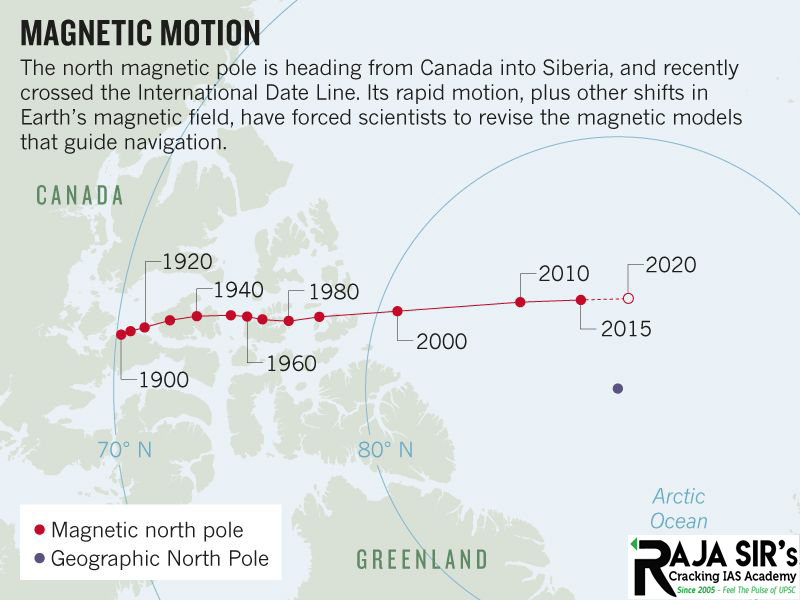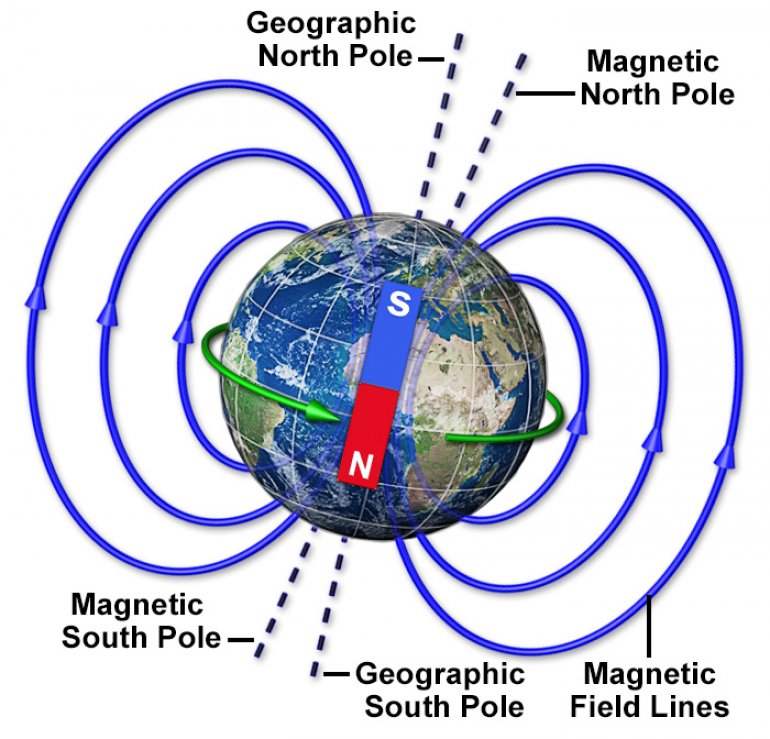- Home
- Prelims
- Mains
- Current Affairs
- Study Materials
- Test Series
 EDITORIALS & ARTICLES
EDITORIALS & ARTICLES
The curious case of wandering north pole
Like a bar magnet, Earth’s magnetic field has also north and south poles. However, unlike the poles of a bar magnet, the poles of Earth’s magnetic field are not static. According to scientists, the intensity of Earth’s magnetic field has also been weakening. As a result, these poles may also flip in future, as has happened numerous times in the past, but not in the last 7,80,000 years. In case the Earth’s magnetic poles flip, what are going to be its consequences? Before delving into all this, let us first discuss the case of drifting magnetic north pole of Earth’s magnetic field.
The movement of the magnetic north pole has been the object of study since 1831 when in June that year British Royal Navy explorer James Clark Ross discovered it in the Canadian Arctic. Since then, it has been constantly on the move and has covered about 2,300 kilometres, its speed jumping from 15 kilometres per year to 55 kilometres per year since 2000. It crossed the international date line in 2017 and is heading towards Siberia.
The precise location of the magnetic north pole is very important for navigation systems, both military and civilian, as well as some smart phones and some consumer electronic devices. That is the reason why its location is updated every five years in December. Its position was to be updated on 31 December 2019. However, in view of the pole’s faster movement, this time the update was done nearly a year ahead of schedule, on 31 January 2019.
Who updates the position of magnetic north pole?
The updating of the location of magnetic north pole is done on the basis of a standard model called World Magnetic Model (WMM). The updating work is done jointly by the US-based national Centres for Environmental Information (NCEI) and the UK-based British Geological Survey (BGS), who were involved with the development of the model.
Calling the fast shifting of the magnetic north pole a problem for compasses in smart phones and some consumer electronic devices, University of Colorado geophysicist Arnaud Chulliat, who is also the head author of the newly issued World magnetic model, said, “The location of the magnetic north pole is updated every five years in December, but this update came early because of the pole’s faster movement.”
What causes the shift? Why does the location of the magnetic north pole shift? Does magnetic south pole also shift its position?
According to scientists, changes occurring in the magnetic field of the Earth are responsible for the shifting position of the magnetic north pole. The location of the magnetic south pole also changes but the rate of its movement is far slower compared to the north pole Let us now understand how the Earth’s magnetic field is produced. For this, we need to know about the inner structure of the Earth. It has an iron core, about 1,270 kilometres thick, made of solid iron. Surrounding the inner core is a molten outer core of thickness 2,200 kilometres. In this outer core, iron and nickel are present in molten form. The next layer out, the mantle, has a thickness of about 2,850 kilometres. It is solid but malleable like plastic. Finally, comes the outermost layer that makes the surface of the Earth, called the crust. It is brittle and has a thickness ranging from 0-100 kilometres. Beneath the oceans, the crust generally extends to about 5 kilometres. The thickness of the crust beneath continents averages about 30 kilometres, while under large mountain ranges, such as Alps or Sierra Nevada, the base of the crust can be as deep as 100 kilometres.
The crust beneath the Himalayas is between 60 and 780 kilometres thick. As Earth spins on its axis, both the inner and outer cores also spin along with it. But, the inner and outer cores spin at different rates. This produces what is known as ‘dynamo effect’, leading to the creation of convection currents in the outer molten core. These convection currents are responsible for the production of Earth’s magnetic field. It is like an electric current flowing through a coil producing a magnetic field. It is the turbulence in the outer core that affects the Earth’s magnetic field, which in turn impacts the location of the magnetic north pole.
In addition to turbulence, irregularities where the core and mantle meet and changes in the Earth’s crust, like earthquakes of large magnitude, can also change the Earth’s magnetic field and hence the location of the magnetic north pole. In addition to the shifting position of the magnetic north pole, the Earth’s magnetic field is also getting weaker which may ultimately lead to the flipping of the magnetic poles of the Earth. This is not quite well understood by the scientists. However, according to the University of Colorado geophysicist Daniel Lathrop, “It (Earth’s magnetic field) has changes akin to weather. We might call it magnetic weather.”
Had we got some means to get information about this magnetic ‘weather’, we would have found out what is going to happen with the Earth’s magnetic field. However, it is difficult to predict the ‘weather’ of the central core of Earth because it is buried deep below 3,000 kilometres under the surface of Earth. Hence, it is difficult to ‘sense’ the core from above.
However, recent technological advances have made possible to take observations of the central core of Earth using geomagnetic observations on Earth and by satellites in space. These observations along with computer modelling and simulation techniques have greatly enhanced our knowledge about the central core of the Earth. A jet stream was discovered in the core a couple of years back. Thanks to recent advancements, it has become possible to predict fairly accurately the behaviour of the central core of Earth and its magnetism.
The implication of the Earth’s magnetic field getting weaker, say the scientists, is that it would eventually flip which, in effect, would mean field reversal. During the course of Earth’s history, such field reversals have happened many times, typically every 2,00,000 to 3,00,000 years. Field reversal means that the magnetic north and south poles would change polarity with north pole slipping towards the bottom of the planet and the south pole moving towards the top.
The last time Earth’s field reversal happened was around 7,80,000 years ago; an incomplete or temporary field reversal occurred about 41,000 years back. The poles may again flip in future but it may take a few thousand years to happen. If a field reversal happens in future, the situation will last for nearly 1,000 years which means the poles will attain their original position only after 1,000 years. The temporary flip that happened 41,000 years ago lasted for 250 years only.
The question is, if field reversal happens in some future point of time, how would it affect life on Earth. Actually, the Earth’s magnetic field is like an invisible sheet enveloping our planet that protects us from the harmful radiations and charged particles coming from the Sun and space. If a reversal of poles takes place in future, our protective shield would weaken, and we would lose protection from damaging radiation and charged particles. This will directly impact our artificial satellites which would greatly hamper our communication system, aviation and power distribution system. According to scientists, our electronic equipment might also be affected by the field reversal, but how actually they would be affected cannot be predicted in exact terms.
It is difficult to predict what will be the impact of the field reversal on life forms on Earth because last time when this happened, some 7,80,000 years ago, no studies were carried out. However, it may be predicted that some migratory birds who, on their long voyages, use Earth’s magnetic field for their flight guidance, might be affected.
Magnetic north pole
The magnetic north pole is actually the north pole of the Earth’s (real) magnetic field. It represents a point on the Northern Hemisphere where earth’s magnetic field points vertically downwards. If you are sitting over the north magnetic pole with a compass, the needle would dip and point straight downward – hence the other name magnetic dip pole. However, over the south magnetic pole, your compass needle would point straight upward.
The magnetic north pole is not just important in precise navigation, it is also responsible for the phenomena of picturesque and dramatic lights, called aurora borealis, observed in the Northern Hemisphere. This is due to the solar radiations bouncing off the Earth’s magnetic field. This phenomena takes place at the Southern Hemisphere also where these spectacular lights are called aurora australis.
Geographic north pole
The geographical north pole is a spot in the Arctic Ocean where man-made line of longitude, known as meridians, converge. This is actually the “True North”, which is also known as “Terrestrial North Pole” and “Geodesic North Pole.”
Instantaneous north pole
As the name suggests, the instantaneous north pole is not a static or fixed point. It represents the point where the rotational axis of the Earth meets its surface and the Celestial North Pole – the point around which all the heavenly bodies of the North Hemisphere can be seen to rotate clockwise. Although instantaneous north pole is close to the geographic north pole, unlike the latter whose position is fixed, it tends to move in a irregular fashion around a circle. Called the Chandler circle, its diameter varies from a few centimetres to a few metres. This circle is named after an American astronomer Seth Carlo Chandler who in 1891 discovered that the Earth wobbles as it rotates about its axis. It is this wobble, known as Chandler wobble, which makes the radius of the Chandler circle irregular. It takes about 14 months for the instantaneous north pole to complete one revolution of the Chandler circle. The average of the positions of the instantaneous north pole is called the ‘north pole of balance.’ It lies at the centre of the Chandler circle. Strictly, the point, called ‘north pole of balance’, is not fixed. It is gradually moving towards North America at around 15 centimetres per year.
Geomagnetic north pole
We may regard the Earth’s complex and varied magnetic field as a big bar magnet or magnetic dipole. The north pole of this bar magnet or magnetic dipole is actually the geomagnetic north pole. However, geomagnetic north pole is totally different from magnetic north pole. While the magnetic north pole lies in Northern Canada, the location of the geomagnetic north pole is roughly off the northwest coast of Greenland.
The magnetic north pole has an important role in navigation, smart phones and some other applications. But, does geomagnetic north pole also have some important role? Commenting on this, Jeffrey J. Love, a U. S. Geophysical Survey geophysicist, said, “But, the geomagnetic pole is useful, if you’re in space. The farther away from Earth you get, the more its magnetic field actually does act like a dipole or a bar magnet – even if in reality there is no such thing.” Love further added, “A space physicist usually thinks in terms of the tilted dipole that the Earth has, whereas a navigator would probably be more interested in the magnetic north pole.”









 Latest News
Latest News



 General Studies
General Studies